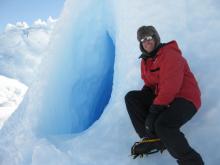What Are They Doing?
Glaciers are like moving rivers of ice, and their rate of movement can vary depending on many factors including friction, the slope of underlying bedrock, and climate. Byrd Glacier is unique because it goes through large changes in its speed in response to two subglacial lakes, lakes that remain unfrozen underneath the glacier, which drain periodically. This project was designed to study the changes in glacier behavior on timescales from minutes to years by closely monitoring Byrd Glacier for the following 2.5 years.
To do this, the research team installed about 30 GPS units on Byrd Glacier. Some of the sensors remained on the glacier during just the 2010-2011-research season (November – February) and some stayed out there and took recordings all year long. The data collected from different parts of the glacier provided a continuous record of horizontal and vertical motions over a 26-month time period.
The results of the study were used in conjunction with a longer record of remote sensing observations. The combined datasets were used to check a numerical model of the glacier’s flow dynamics, or changes in rates of movement. The modeling efforts were applied to other East Antarctic outlet glaciers so that scientists could develop a better understanding of glacier behavior in Antarctica.
The research team made two trips to Antarctica as part of the same project, first from 8-25 November 2010 and later in the field season from 29 January - 12 February 2011.
Where Are They?
The research team was based at McMurdo Station, and traveled daily by helicopter to the research site on Byrd Glacier, about 250 miles (400 km) from the station. Byrd Glacier is one of Earth’s largest glaciers, starting in East Antarctica and flowing through the Transantarctic Mountains and into the Ross Ice Shelf. It is about 84 miles (136 km) long and about 15 miles (24 km) wide – an area greater than most U.S. cities!
Latest Journals

Dr. Leigh Stearns is an Assistant Professor in the Department of Geology at the University of Kansas (KU) and CReSIS. She joined the KU faculty in 2009 after receiving her PhD at the University of Maine. Her research focus is on outlet glacier dynamics, which she studies by integrating remote sensing and field-based measurements into numerical models. In her spare time, she likes to bike, swim, walk her dog, garden, volunteer, and run!

Gordon Hamilton is a Professor with a joint appointment in the School of Earth and Climate Sciences and the Climate Change Institute at the University of Maine. Dr. Hamilton studies ice sheet mass balance and the role of ice sheets in modulating global sea levels. Current research focuses on understanding the dynamics of outlet glaciers and ice shelves in Greenland and Antarctica, ice-ocean interactions in Greenland, snow distribution across the polar ice sheets. This work involves field experiments, satellite remote sensing and numerical modeling. Prior to arriving at UMaine, he was a research scientist at Ohio State’s Byrd Polar Research Center and the Norwegian Polar Institute. He received his PhD in Geophysics from the University of Cambridge.

Dr. Kees van der Veen is a Professor in the Geography Department and with CReSIS, at the University of Kansas. His research interests are in the dynamics of tidewater glaciers, iceberg calving, and improving our current glacier flow models to capture the small- and large-scale changes in ice dynamics that are occurring in the polar regions. Dr. van der Veen will be in charge of developing the numerical models of Byrd Glacier in the Byrd Glacier Flow Dynamics project. In his spare time, he likes to show off his vintage Volkswagen in local parades and car shows!


